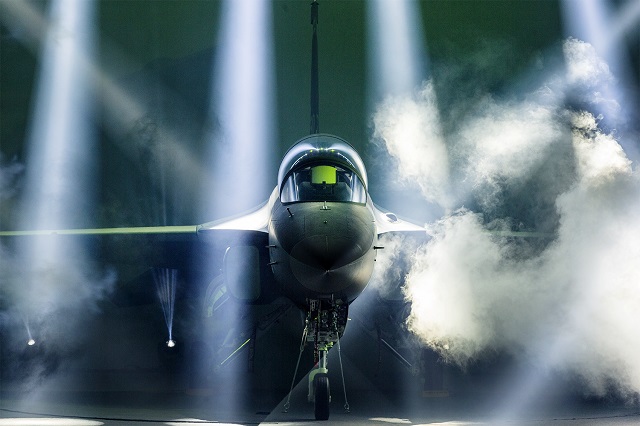One year ago this week, Lockheed Martin Skunk Works chief Rob Weiss announced that his advanced design team had been working on a clean-sheet aircraft for the US Air Force’s T-X programme as a potential alternative to the South Korean T-50 Golden Eagle, which Lockheed jointly developed with Korea Aerospace Industries (KAI) and now exports around the globe.
That announcement was heard across the world, including in Korea, where the government spent billions of dollars to jointly develop the F-16 spinoff T-50 and procure the F-35 Lightning II. Indeed, Korea and Indonesia had even inked a deal to codevelop the KF-X fighter with significant technology transfer from the USA via Lockheed.
Last week, in the same Lockheed office in Washington DC where the clean-sheet was first disclosed, Lockheed declared that alternative design effort over, in favour of a block upgrade of the KAI Golden Eagle trainer known as T-50A.
At stake is a multibillion-dollar programme to produce 350 next-generation training aircraft and associated ground-based training systems to replace the 45-year-old Northrop T-38C Talon.
That announcement would have come as a relief to South Korea, which first unveiled its Lockheed-KAI T-50A offer for T-X with much pomp and ceremony in December.

Lockheed Martin
“Frankly, when it came out last year in the media there was some concern,” Weiss tells Flightglobal. “I said we’ll be on stronger ground when we have done the work and really understand what the facts and the data tell us about a clean-sheet versus the T-50. Frankly, they’ve been as anxious as anyone to understand and hear the results of our study. They certainly understood why we had to do what we did.”
Skunk Works has built its reputation in the classified world, producing revolutionary and legendary aircraft such as the U-2, SR-71 and F-117 – the world’s first stealthy attack aircraft.
Today, the organisation is working on a variety of next-generation weapons systems from the “UQ-X” optionally piloted replacement for its U-2, to the air force and navy’s next air dominance platforms. Other projects include including ship and land-based unmanned combat jets and new battle management aircraft like the E-8C "JSTARS" replacement, Weiss explained in 2014.

Lockheed Martin
So why did such an organisation choose a mostly Korean-built trainer aircraft over something developed internally? According to Weiss, it came down to the metrics of cost, capability, schedule and risk.
He says work ceased on the clean-sheet alternative in late 2015 with 80% of the detailed design work complete, approximately five years after the two-pronged approach to T-X was approved.
“It’s in the DNA of the Skunk Works to design new airplanes," Weiss explais. “This was a very sweet airplane and folks were passionate about it. It was very capable and it would do everything the US Air Force was looking for in the T-X aircraft.
“[But] we’re all-in on the T-50 now and we’re comfortable about that. “We’re happy we did that study because now we understand the facts and the data. The facts and the data are that this is the right solution for the US air force because it’s here now, it meets their capability requirements, there’s no schedule risk.”
The T-50A will be delivered as a block upgrade to the baseline T-50. It adds an embedded training system, fifth-generation cockpit, open system architecture and in-flight refuelling.
Weiss says the clean-sheet alternative might have cost approximately eight times more to develop, without adding significant capability “beyond a modernised T-50”. Moreover, it would struggle to meet the air force’s recently revised initial operational capability (IOC) date of 2024.
“Our team thought we had a really, really fine airplane . . . but it doesn’t do any more than the T-50 already does, so at the end of the day – it costs more, takes longer, has higher risk and without adding significant value beyond the T-50," Weiss says. “That baseline [T-50] aircraft has over 100,000 flight hours. It’s very mature. It’s trained more than 1,000 pilots today.”
The T-50A would be delivered from Lockheed’s Greenville, South Carolina plant, which specialises in “nose-to-tail modification, maintenance, repair and overhaul” of in-service types. Lockheed is establishing a “warm” T-50A final assembly and checkout line there that should be ready by year’s end.
The first two production-representative prototypes are being built, unveiled and flown for the first time in Korea but will arrive in America later this year for flight demonstrations. Weiss encouraged the air force to conduct a flight evaluation and he says new trainers could start rolling off the Greenville assembly line “within months” of a T-X contract award.

Lockheed Martin
“For the US Air Force to be flying our finest women and men in an airplane that’s almost 50 years old is just unacceptable in my mind,” he says. “That’s where the T-50 shines. It meets all the capability requirements, so a clean sheet from anyone else is not going to provide additional capability. The cost of developing [a new] airplane is substantially higher and it’s got all the schedule risk in it.”
The air force responded to Lockheed’s proposal during a budget briefing on 12 February, saying it remains committed to holding a fair and open competition between the clean-sheets proposed by Boeing and Saab, Northrop Grumman and BAE Systems and the T-50 and T-100 derivatives proposed by Lockheed-KAI and Finmeccanica-Alenia Aermacchi respectively.
“We think we have a good [acquisition plan] that pits the people who have purpose-built and modified airplanes,” says deputy chief of staff for plans and requirements Lt Gen James Holmes.
The air force’s latest five-year spending plan includes $943 million for “advanced pilot training” research and development plus $63.5 million for the production of long-lead parts. IOC would be 2024, about one year later than planned due to “budget realities”.
Source: FlightGlobal.com
















